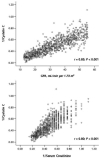Association of cystatin C with adverse outcomes
- PMID: 19374014
- PMCID: PMC2890263
- DOI: 10.1097/mnh.0b013e328326f3dd
Association of cystatin C with adverse outcomes
Abstract
Purpose of review: To discuss recent studies which have evaluated determinants of cystatin C and to focus on the relationship of cystatin C with mortality, cardiovascular disease (CVD), and noncardiovascular outcomes.
Recent findings: In the Chronic Kidney Disease Epidemiology Study cystatin C was associated with demographic characteristics independent of measured glomerular filtration rate (GFR), although this was to a smaller extent than creatinine. In patients with established chronic kidney disease (CKD), cystatin C was strongly and inversely correlated with measured GFR, suggesting that although cystatin C may have other determinants, it is primarily a measure of kidney function. Several cohort studies, particularly in older adults, have now demonstrated that cystatin C is linearly associated with mortality, CVD and non-CVD outcomes, whereas creatinine is primarily associated with risk in individuals with more advanced kidney disease. A recent study has also shown that changes in kidney function as ascertained by cystatin C, even within the relatively normal range, are associated with subsequent CVD and all-cause mortality among older adults.
Summary: Cystatin C appears to capture an association of mild kidney disease with increased risk of mortality, CVD and non-CVD outcomes. Future studies should evaluate whether cystatin C can improve medical decision-making and lead to favorable patient outcomes.
Figures



Similar articles
-
Cystatin C identifies cardiovascular risk better than creatinine-based estimates of glomerular filtration in middle-aged individuals without a history of cardiovascular disease.J Intern Med. 2014 May;275(5):506-21. doi: 10.1111/joim.12169. Epub 2013 Dec 20. J Intern Med. 2014. PMID: 24279862
-
Kidney Function as Risk Factor and Predictor of Cardiovascular Outcomes and Mortality Among Older Adults.Am J Kidney Dis. 2021 Mar;77(3):386-396.e1. doi: 10.1053/j.ajkd.2020.09.015. Epub 2020 Nov 14. Am J Kidney Dis. 2021. PMID: 33197533
-
Cystatin C as a risk factor for outcomes in chronic kidney disease.Ann Intern Med. 2007 Jul 3;147(1):19-27. doi: 10.7326/0003-4819-147-1-200707030-00004. Ann Intern Med. 2007. PMID: 17606957 Clinical Trial.
-
[Cystatin C and cardiovascular risk].Ann Biol Clin (Paris). 2010 Sep-Oct;68(5):517-29. doi: 10.1684/abc.2010.0466. Ann Biol Clin (Paris). 2010. PMID: 20870574 Review. French.
-
[New topics regarding equations for GFR estimation based on serum creatinine and cystatin C].Rinsho Byori. 2014 Feb;62(2):153-62. Rinsho Byori. 2014. PMID: 24800491 Review. Japanese.
Cited by
-
Long-term prognostic impact of cystatin C on acute coronary syndrome octogenarians with diabetes mellitus.Cardiovasc Diabetol. 2013 Nov 1;12:157. doi: 10.1186/1475-2840-12-157. Cardiovasc Diabetol. 2013. PMID: 24182196 Free PMC article.
-
Insights into Cognitive Brain Health in Chronic Kidney Disease.Gerontol Geriatr. 2022;8(2):1074. doi: 10.26420/gerontolgeriatrres.2022.1074. Epub 2022 Aug 5. Gerontol Geriatr. 2022. PMID: 37671071 Free PMC article.
-
Biomarkers in chronic kidney disease, from kidney function to kidney damage.World J Nephrol. 2015 Feb 6;4(1):57-73. doi: 10.5527/wjn.v4.i1.57. World J Nephrol. 2015. PMID: 25664247 Free PMC article. Review.
-
Body mass index and preclinical kidney disease in Indian adults aged 40 years and above without chronic kidney disease.Clin Exp Nephrol. 2014 Dec;18(6):919-24. doi: 10.1007/s10157-014-0945-6. Epub 2014 Feb 14. Clin Exp Nephrol. 2014. PMID: 24526413
-
Cystatin C: a candidate biomarker for amyotrophic lateral sclerosis.PLoS One. 2010 Dec 9;5(12):e15133. doi: 10.1371/journal.pone.0015133. PLoS One. 2010. PMID: 21151566 Free PMC article.
References
-
- Köttgen A, Selvin E, Stevens LA, et al. Serum cystatin C in the United States: The Third National Health and Nutrition Examination Survey (NHANES III) Am J Kidney Dis. 2008;51:385–394. This analysis from the Third National Health and Nutrition Examination Survey (NHANES III) evaluates the determinants of cystatin C across a wide age range and different ethnicities. Serum cystatin C level was related to sex and ethnicity, even in young healthy individuals. The prevalence of increased cystatin C levels increased dramatically with age, reaching greater than 50% after the age of 80 years in both sexes and all ethnic groups. - PubMed
-
- Stevens LA, Coresh J, Schmid CH, et al. Estimating GFR using serum cystatin C alone and in combination with serum creatinine: A pooled analysis of 3,418 individuals with CKD. Am J Kidney Dis. 2008;51:395–406. In a pooled analyses of 3,418 individuals with CKD (mean GFR 48 ml/min/1.73 m2), serum cystatin C level alone provided GFR estimates that were nearly as accurate as serum creatinine level adjusted for age, sex, and race. An equation including serum cystatin C level in combination with serum creatinine level, age, sex, and race provided the most accurate estimate of GFR. - PMC - PubMed
-
- Knight EL, Verhave JC, Spiegelman D, et al. Factors influencing serum cystatin C levels other than renal function and the impact on renal function measurement. Kidney Int. 2004;65:1416–1421. - PubMed
-
- Manetti L, Pardini E, Genovesi M, et al. Thyroid function differently affects serum cystatin C and creatinine concentrations. J Endocrinol Invest. 2005;28(4):346–9. 2005. - PubMed
-
- Risch L, Herklotz R, Blumberg A, et al. Effects of glucocorticoid immunosuppression on serum cystatin C concentrations in renal transplant patients. Clin Chem. 2001;47(11):2055–9. - PubMed
Publication types
MeSH terms
Substances
Grants and funding
LinkOut - more resources
Full Text Sources
Medical
Research Materials

